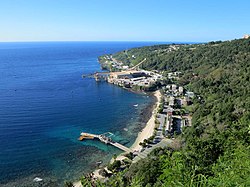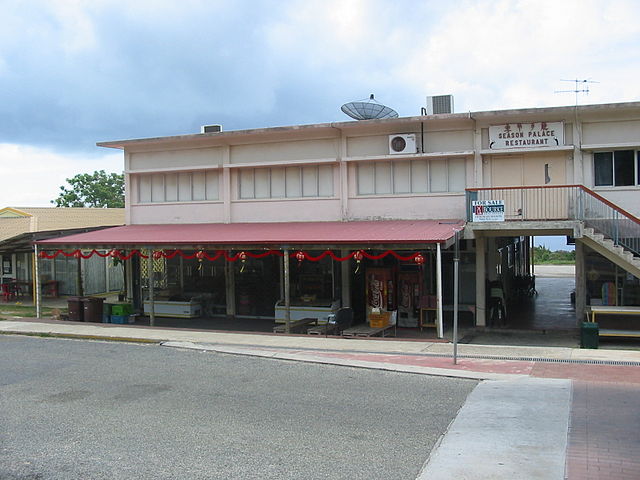Christmas Island
island and external territory of Australia, located in the Indian Ocean From Wikipedia, the free encyclopedia
The Territory of Christmas Island is a small island that belongs to Australia. It is in the Indian Ocean, about 2600 kms northwest of Perth in Western Australia and 500 kms south of Jakarta, Indonesia.
Christmas Island | |
|---|---|
| Territory of Christmas Island 圣诞岛领地 / 聖誕島領地 (Chinese) Wilayah Pulau Krismas (Malay) | |
 Flying Fish Cove, the territory's capital | |
 Location of Christmas Island (red circle) and the location of Australia mainland (continent in red) | |
| Sovereign state | Australia |
| British annexation | 6 June 1888 |
| Transferred from Singapore to Australia | 1 October 1958 |
| Named for | Christmas Day |
| Capital and largest city | Flying Fish Cove ("The Settlement") 10°25′18″S 105°40′41″E |
| Official languages | None[a] |
| Spoken languages | |
| Ethnic groups |
|
| Demonym(s) | Christmas Islander |
| Government | Directly administered dependency |
• Monarch | Charles III |
| David Hurley | |
• Administrator | Natasha Griggs |
• Shire President | Gordon Thompson |
| Parliament of Australia | |
• Senate | represented by Northern Territory senators |
| included in the Division of Lingiari | |
| Area | |
• Total | 135 km2 (52 sq mi) |
• Water (%) | 0 |
| Highest elevation | 361 m (1,184 ft) |
| Population | |
• 2021 census | 1,692[1] (not ranked) |
• Density | 10.39/km2 (26.9/sq mi) (not ranked) |
| GDP (nominal) | 2010 estimate |
• Total | US$52,177,900[2] |
| Currency | Australian dollar (AU$) (AUD) |
| Time zone | UTC+07:00 (CXT) |
| Driving side | left |
| Calling code | +61 891 |
| Postcode | WA 6798 |
| ISO 3166 code | CX |
| Internet TLD | .cx[3] |
| Christmas Island | |||||||||||||||
| Simplified Chinese | 圣诞岛 | ||||||||||||||
|---|---|---|---|---|---|---|---|---|---|---|---|---|---|---|---|
| Traditional Chinese | 聖誕島 | ||||||||||||||
| |||||||||||||||
| Territory of Christmas Island | |||||||||||||||
| Simplified Chinese | 圣诞岛领地 | ||||||||||||||
| Traditional Chinese | 聖誕島領地 | ||||||||||||||
| |||||||||||||||


About 1,600 people live on Christmas Island, mostly in a number of "settlement areas" on the north of the island:
- Flying Fish Cove
- Silver City
- Poon Saan
- Drumsite
Christmas Island is far from other islands. That is why many of the plants and animals are only found on that Island.[4] Much of it is undisturbed by humans.
There used to be mining on the island, but now 65% of Christmas Island is National Park.
History
Captain William Mynors of the British East India Company ship, the Royal Mary, gave the island its name because they arrived on Christmas Day, 25 December 1643.
The earliest recorded visit was in March 1688 by William Dampier of the British ship Cygnet. Dampier was blown away from the direction he wanted to go, and he got lost. After 28 days he arrived on Christmas Island. Two of his crewmen were the first recorded people to set foot on Christmas Island.
There were several visits and explorations of the island, but it was only when valuable phosphate of lime was discovered that the island was annexed to (claimed by) the British Crown on 6 June 1888.
Settlement and exploitation
Soon afterwards, a small settlement was started in Flying Fish Cove by G. Clunies Ross, the owner of the Keeling Islands (some 900 kilometres to the south west) to collect timber and supplies for the growing industry on Cocos.
Phosphate mining began in the 1890s using indentured workers from Singapore, China, and Malaysia.
The island was ruled jointly by the British Phosphate Commissioners and District Officers from the United Kingdom Colonial Office through the Straits Settlements, and later the Crown Colony of Singapore.
Japanese invasion
Japan invaded and occupied the island in 1942, as the Indian garrison mutinied, and they interned the residents (made them stay where they were) until the end of World War II in 1945.
Transfer to Australia
Australia asked the United Kingdom to allow them to rule the island; in 1957, the Australian government paid the government of Singapore £2.9 million in compensation. This amount of money was decided by guessing how much the phosphate given up by Singapore was worth.
The first Australian Official Representative arrived in 1958 and was replaced by an Administrator in 1968. Christmas Island and the Cocos (Keeling) Islands together are called the Australian Indian Ocean Territories and since 1997 share one Administrator who lives on Christmas Island.
Since the late 1980s boatloads of refugees have gone to Christmas Island, mostly from Indonesia. During 2001, Christmas Island received a large number of asylum seekers travelling by boat, most of them from the Middle East and intending to apply for asylum in Australia. The Norwegian cargo vessel MV Tampa rescued people from a sinking Indonesian fishing-boat Palapa. The ship had 420 asylum seekers from Afghanistan, 13 from Sri Lanka, and five from Indonesia. The captain of the ship asked to let the refugees leave the ship at Christmas Island. The Australian SAS boarded and took control. The asylum seekers were sent to Nauru. Another boatload of asylum seekers was taken from Christmas Island to Papua New Guinea. It was said that many of the adult asylum seekers threw their children into the water in protest at being turned away. This was later proved to be untrue. Many of the refugees were accepted by New Zealand.
The Australian Parliament later passed a law to ban people who arrive on Christmas Island from being able automatically to claim refugee status. This allows the Australian navy to move them to other countries (Papua New Guinea's Manus Island, and Nauru). In 2005, the Department of Immigration began to build an "Immigration Reception and Processing Centre", completed in 2007 at the cost of $210 million. It has 800 beds.[source?]
Government
Christmas Island is a non-self governing territory of Australia. The King of Australia is represented by an administrator appointed by the Governor-General. Neil Lucas was appointed administrator on 28 January 2006.
Federal government services are provided through the Department of Transport and Regional Services and the Christmas Island Administration.
The Western Australian Government and other contractors provide state government services, but because Christmas Island is a territory the Commonwealth (federal) Australian Government pay the costs.
The local government is the Shire of Christmas Island. This council has 9 members, half the members are elected every two years.
Christmas Island residents who are Australian citizens also vote in Commonwealth elections for the Northern Territory's Lingiari constituency of the House of Representatives. They are represented in the Senate by Northern Territory Senators.
In early 1986 the Christmas Island Assembly held a design competition for an island flag; the winning design was adopted as the informal flag of the territory for more than ten years, and in 2002 it was made the official flag of Christmas Island.
The annual red crab mass migration (around 100 million animals) to the sea to spawn has been called one of the wonders of the natural world[5] and takes place each year around November; after the start of the wet season and in synchronisation with the cycle of the moon.
Tourism
The Christmas Island National Park covers 63% of the island. This means that for the visitor interested in plants and animals there is a great deal to see. There is also lots of amazing marine life in the sea.
Plants and Animals
- Christmas Island Pipistrelle is a very small bat that only lives on Christmas Island. It is listed as a Critically endangered species. In 2008 there were only about 20 bats left and scientists thought that they could become extinct during 2009.[6] There has been a number of searches for the bat, but none have been seen since 27 August 2009. The ICUN believes that the bat is now extinct.[7]
Bibliography
- CIA World Factbook 2002
- Charles. W. Andrews, A Description of Christmas Island (Indian Ocean). Geographical Journal, 13(1), 17-35 (1899).
- Charles W. Andrews, A Monograph of Christmas Island, London,1900.
- National Library of Australia, The Indian Ocean: a select bibliography. 1979 ISBN 0-642-99150-2
- W. J. L. Wharton, Account of Christmas Island, Indian Ocean. Proceedings of the Royal Geographical Society and Monthly Record of Geography, 10 (10), 613-624 (1888).
Other websites
General
- Christmas Island Shire official website
- Christmas Island Act 1958 Archived 2008-12-18 at the Wayback Machine
- Christmas Island at the Open Directory Project
- Christmas Island Archived 2018-12-25 at the Wayback Machine in the CIA World Factbook
Tourism
- Christmas Island Travel Guide from Unearth Travel a creative commons travel wiki
References
Notes
Wikiwand - on
Seamless Wikipedia browsing. On steroids.

